
Travel Tales of the Unexpected
The joy of trains ± First time in India
Eclipse chasing ± Off-grid getaways


The joy of trains ± First time in India
Eclipse chasing ± Off-grid getaways


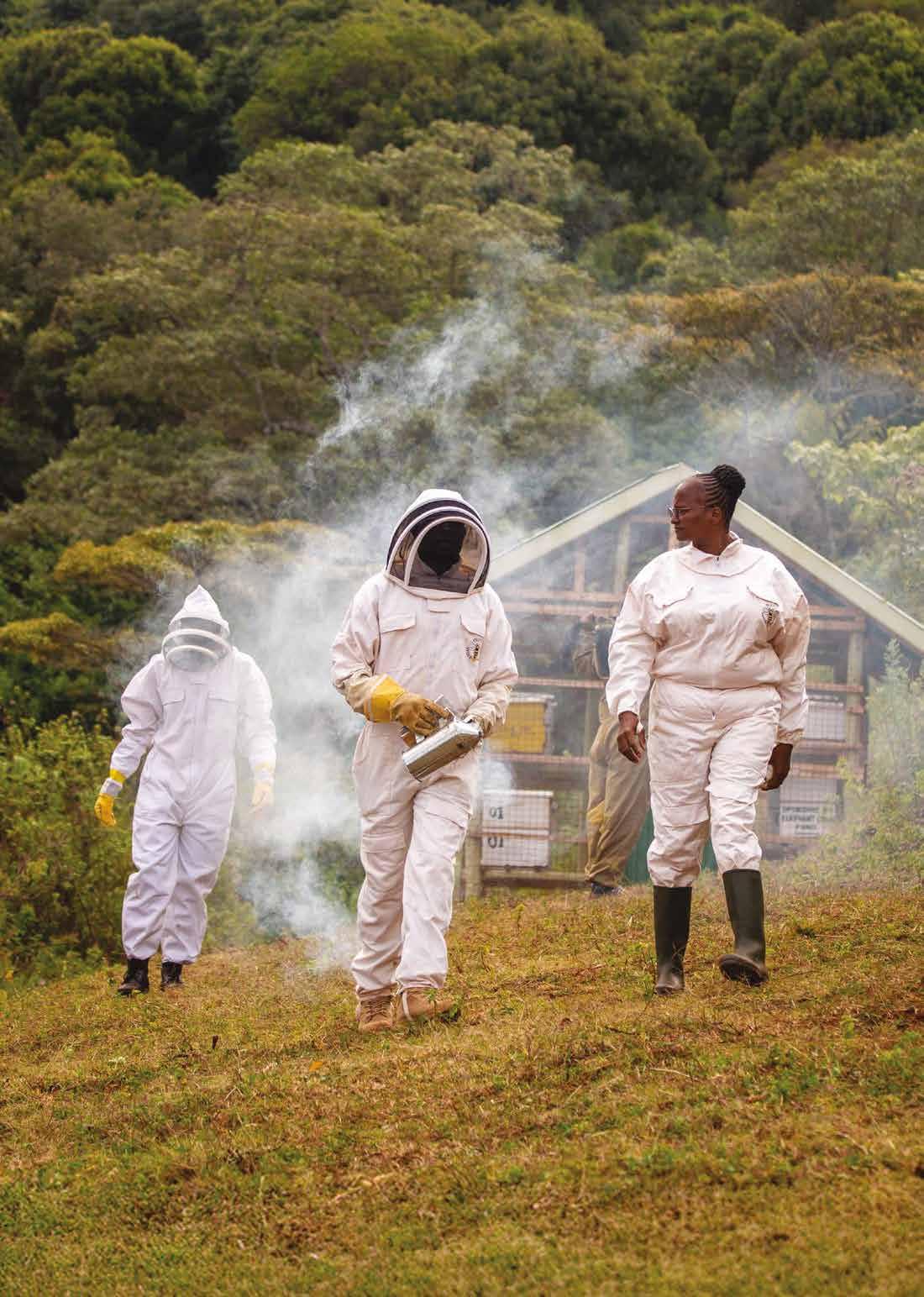

There’s something about this time of year that always sets me thinking about where to go next. Perhaps it’s the change of season, the addition of new destinations to our programme, or simply the joy of looking ahead to a new adventure.
This issue is full of the kind of stories that spark that sense of anticipation. We’ve got an inspiring first-timer’s tale from India, a closer look at Albania’s many hidden treasures, and a fascinating feature on how beekeepers in Tanzania are playing a surprising role in protecting elephants. There are also some beautiful rail journeys to tempt you and, for the brave, a handful of atmospheric walks perfectly suited to the season.
Whether you’re planning your next trip or simply enjoying some armchair travel, I hope these pages remind you of the thrill of discovering somewhere new – and perhaps inspire your next journey.



By her own admission, Hannah Methven, Explore’s Sustainability Specialist, has always been a train travel geek. We asked her to choose the most memorable journeys.
There’s something about trains that people find inherently charming, from the historic huff and puff of the steam railway to the sleek and serene whisk of modern high speed. As well as many hours on bonerattling local lines in the UK, through my work I’ve been lucky enough to take some of the major tick-box train journeys that many talk about. I’ve wound around picture perfect mountains on Switzerland’s stunning Bernina route, rattled through southern India and sped across Japan on the famous Shinkansen. I’ve even travelled to Sicily by train, which involved the train carriage being loaded onto a ferry! Every time, it’s felt like more than just a mode of transportation. Here are just a few of my favourite trips where the trains take centre stage.
Few train journeys come with a bigger sense of anticipation than the ride to Machu Picchu. On day 12 of our Upgraded Peru trip, you’ll board the 360° train – complete with panoramic windows and an open-air observation carriage –for a truly immersive experience. The route hugs the edge of the Urubamba River, winding past snow-capped peaks, cloud forest and Inca terraces as you make your way towards the iconic citadel.
explore.co.uk/DPRA

Chugging up into the Himalayan foothills, the Kalka–Shimla Toy Train is a joyful throwback to the golden age of rail.
On day seven of our Highlights of Northern India trip, you’ll hop aboard this narrow-gauge line for a leisurely, twisting climb past pine forests, hillside villages and colonial-era stations. It’s not fast –but that’s all part of the charm. explore.co.uk/HFH


Nanu Oyu to Demodara
The train journey through Sri Lanka’s hill country meanders through lush tea estates, offering spectacular valley vistas as you traverse the iconic Nine Arch Bridge, aptly nicknamed the Bridge in the Sky, providing perfect opportunities to admire the breathtaking scenery and meet friendly locals. explore.co.uk/SL
Footsteps of the Shogun
Japan’s rail network is the envy of the world –fast, punctual and famously smooth. On this trip, it’s also the perfect way to trace the ancient Tokaido route, travelling from modern Tokyo to timeless Kyoto and beyond. You’ll ride both local lines and the iconic Shinkansen bullet trains, making the journey feel like a cultural experience in itself.
explore.co.uk/JS



From the turquoise bays of Montenegro to the mountainous heart of Kosovo, this journey weaves together a patchwork of landscapes, cultures and railways – including one of Europe’s most spectacular train rides, the Belgrade to Bar line. It’s a scenic, slow-travel odyssey through lesser-visited corners of Eastern Europe. Expect rustic stations, vintage carriages, and panoramic views you’d struggle to see any other way. explore.co.uk/YUG
First-timer Fathom Stead expected to be overwhelmed by India. What she didn’t expect was to find humour, joy and a sense of serenity.

I’d been told that India was a bit like Marmite –you’d either love it or you’d hate it. I’m just back from my first trip, and I’m definitely a lover! Go in with open arms, lean into the chaos, be ready to embrace it all and you won’t be disappointed. I definitely wasn’t.
There’s no doubt that even as a seasoned traveller I was a little apprehensive before I left. Apprehensive but intrigued too, and keen to understand the history and heart of a country I had always been curious about. I expected it to be big – overwhelming, even –and an assault on the senses (a term I’d often heard used to describe India). I knew the rules around cleanliness and avoiding illness (don’t eat the salads, avoid buffets left out too long, listen to your tour leader, take their lead on street food etc).

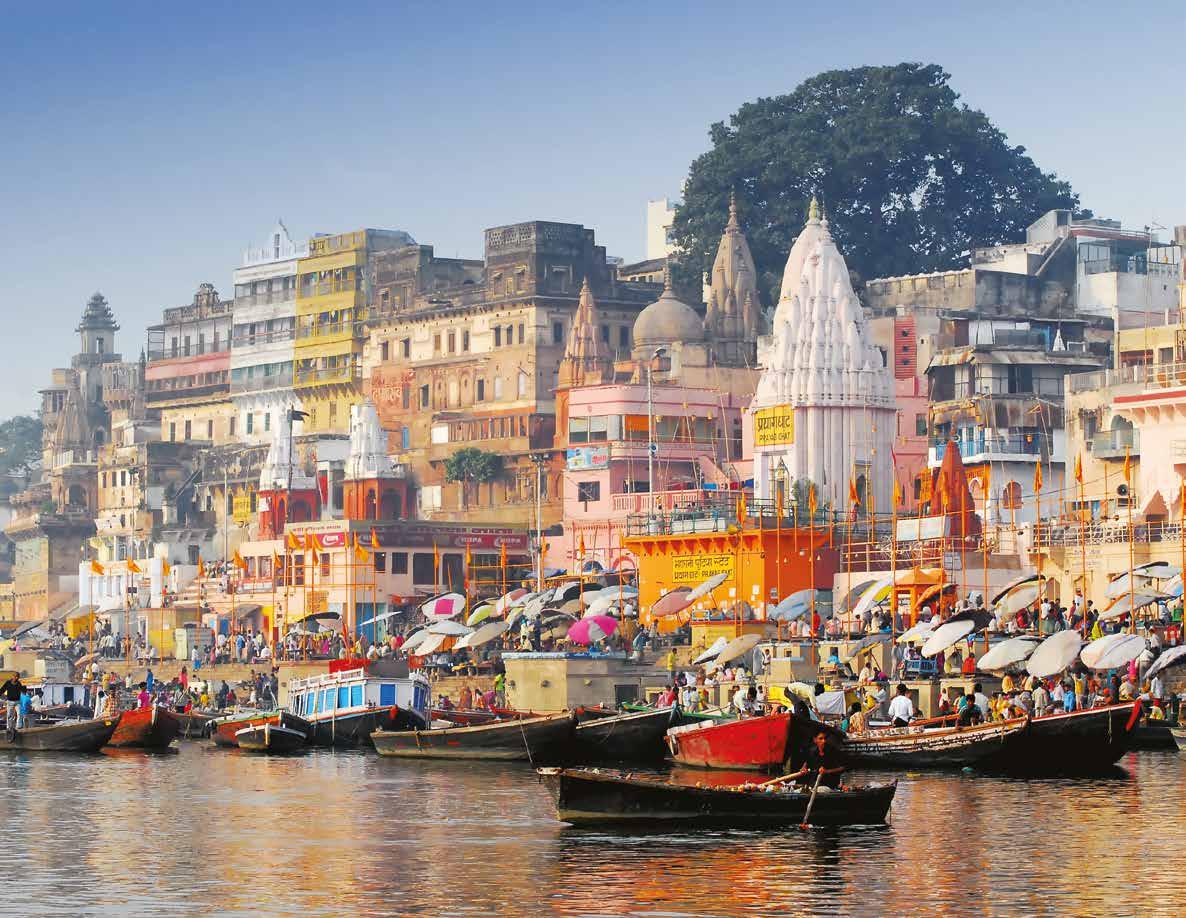
“One of my fellow travellers, Heather, embraced every moment of her first time in India. She wrote a poem about our adventure.”
You can find it here: explore.co.uk/poem
What I was a little anxious about was not wanting to offend in terms of behaviour, and how to dress appropriately, especially as a woman. So, I did my research, and packed plenty of light, loose-fitting clothes in natural materials, and thin scarves to protect me from the sun and cover my arms and legs when it was necessary to do so.
The trip I chose certainly helped balance the light and shade: a 15-day in-depth tour of Northern India. The route covered off the iconic Delhi, Agra and Jaipur, but also included wildlife spotting, a boat safari and the spiritual buzz of Varanasi. The perfect mix for a first-time traveller to India wanting to explore beyond the famous Golden Triangle.
From Delhi to Jaipur, from Pushkar to Ranthambore, from Agra to Chambal, from Varanasi back to Delhi, our group covered a lot of ground! Travelling by bus, by sleeper train, by boat, by 4WD, we took it all in our stride, knowing this was the best way of experiencing the true India. Chaotic times balanced out with calm moments. Expected moments and moments that took me completely by surprise.
A highlight for me was in fact our bus journeys, a time to rest and watch daily life in India unfold through the window. I surprised myself by how much I loved how busy it was, and how there was order within the chaos, as if there were unwritten rules, which we were not yet familiar

“Apprehensive but intrigued too, and keen to understand the history and heart of a country I had always been curious about.”
with, on how to navigate the roads. In Jaipur we watched drivers, using horns rather than indicators, navigating a roundabout where there were no rules, alongside cows, street vendors and tuk-tuks. It was hectic and hugely entertaining! Amazingly there were no casualties.
Maybe it was the flow of the itinerary that helped manage the intensity of this extraordinary country. For example, the tour of the Chambal region came halfway through our trip – learning about its ecosystem and journeying up Chambal River’s serene waterways to observe wildlife gave us a chance to catch our breath after the drama of the Taj Mahal (which, I adhere, deserves its reputation as the most beautiful building in the world).
“The sheer number of bodies in such a small space, this spiritual heart of the country proved a feast for the eyes, and the best people watching experience.”

By the time we reached Varanasi, we were already 12 days into the madness, so our eyes and ears were well trained. But if we were wondering if India could get any busier, then Varanasi, the epicentre of spirituality and the oldest continually inhabited city on Earth, confirmed it could! The sheer number of bodies in such a small space, this spiritual heart of the country proved a feast for the eyes, and the best people watching experience. And yet, the sunrise boat trip up the Ganges was a different vibe altogether –witnessing the cremation process as life comes full circle was peaceful and serene. And this was India for me, crazy and quiet, chaotic and calm.

The most memorable, and unexpected moment for me was the boat safari along the Chambal River. Cruising along pure waters, sighting gharial crocs, Gangetic dolphins, soft shell turtles, gold headed eagles, deer, and local life, it was a twitcher’s paradise.
My advice to first timers? To get the most out of India, go with an open mind. You don’t need to understand or know everything before you go but have realistic expectations. I knew it would be busy, but go with the flow, embrace the colours, the smells and the noise, and the chaos will wash over you. There are calm moments to be found amongst the chaos (after all, India is the birthplace of yoga).
One thing that stayed with me is that Indians embrace and live life to the fullest. They celebrate when there’s a wedding, and they celebrate when there’s a death. Life is joyful, and death can be too. My trip helped me put things into perspective and it also made me eager to explore more of this rich and beautiful country. Next up? Perhaps a trip up to the remote Ladakh region in Northern India. With an open mind of course!
Would you like to experience Fathom’s India adventure? She was on the 15-day Highlights of Northern India tour. explore.co.uk/DIH

We had a chat with Holly Budge from ‘How Many Elephants’, the Explore Foundation’s latest community project, about protecting elephants, empowering women, and harnessing the power of bees in Tanzania.
Tell us about the beehive fence project – what is it and why does it matter?
In Tanzania’s Ngorongoro–Serengeti ecosystem, a key elephant migration route runs directly alongside farmland. As elephants search for food, they often raid crops – devastating harvests, threatening livelihoods, and sometimes leading to retaliation against the elephants themselves. Our solution? Bees. Elephants are naturally afraid of them, so by stringing beehives along farmland boundaries, we can safely deter elephants from entering – without harm to people or wildlife. The results have been remarkable: in some areas, crop damage has dropped by over 90%. With funding from the Explore Foundation and in partnership with Wild Survivors, we’ve built a one-kilometre ‘How Many Elephants Beehive Fence’, made up of 50 hives and home to over two million wild bees.

What are the wider benefits of the beehive fence project?
How has community empowerment helped make the project a success?
“By putting local women at the heart of the project, we’re not just reducing conflict – we’re building opportunity.”
This is more than just an elephant deterrent. The bees pollinate nearby farmland, helping to improve crop yields. And the honey is harvested, processed and sold by the NARI Women’s Beekeeping Group – creating jobs, income and empowerment in a space that’s traditionally male-dominated. As Francesca Mahoney from Wild Survivors says, “The women beekeepers are bravely pushing past boundaries. Their impact goes beyond making honey; they champion female leadership and inspire the community to protect the forests and coexist with elephants.”

It’s been absolutely central. By putting local women at the heart of the project, we’re not just reducing conflict – we’re building opportunity. These women are role models, reshaping what leadership looks like in their communities, and helping to foster a culture of conservation that benefits everyone. What difference has the Explore Foundation made?
The Explore Foundation didn’t just fund a fence – they helped us turn a bold idea into measurable, meaningful impact. Their support allowed us to launch the first kilometre of this innovative, nature-based solution. As Hannah Methven from the Foundation puts it, “We love funding initiatives that demonstrate real, tangible impact, and the beehive fence is a perfect example. It protects both elephants and humans, and provides additional income and security to the community. We’re thrilled to play a small part.”
What’s next for the project?
We’re now raising funds to expand the fence, train more women beekeepers, and protect even more elephants. This is conservation at its best – non-lethal, community-led, and driven by nature. Thanks to the Explore Foundation, we’ve shown what’s possible. Now we’re ready to go further.
Would you like to learn more about the Explore Foundations work and projects we support all across the globe? Visit theexplore.foundation
Spotting native wildlife is always an exciting part of travel. But let’s face it: not all encounters are created equal. Here are five animal sightings that make the world stand still.
In the lush cloud forests and national parks of Costa Rica, spotting a sloth in the wild is pure magic. These famously slow-moving creatures lounge high in the trees, perfectly camouflaged in the canopy. You’ll track them through misty trails, riverbanks and coffee plantations – often alongside toucans and monkeys, but it’s the sloth’s sleepy charm that tends to steal the show.
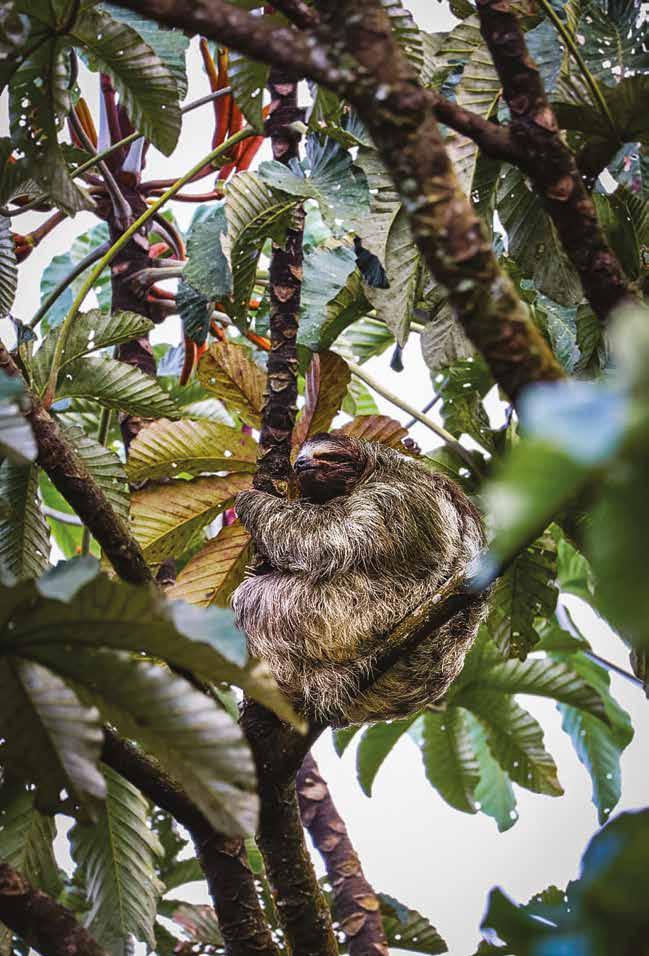
Chitwan National Park is one of Asia’s best places to see the rare and remarkable one-horned rhinoceros. You’ll venture into the park on foot and by canoe, watching for rhinos ambling through the forest or cooling off in muddy pools. Their sheer size and prehistoric appearance make for a heart-stirring wildlife moment in this peaceful pocket of the Terai lowlands.
Nowhere else on Earth offers the chance to see lemurs like Madagascar does. You’ll seek out these playful, wide-eyed primates in their natural habitat – leaping through tree canopies, sunbathing in yoga-like poses, or calling to one another across the forest. From ring-tailed lemurs to the hauntingly vocal indri, each encounter feels like stepping into an entirely otherworldly ecosystem.
2 3 4 5




There are few wildlife moments as humbling as locking eyes with a wild mountain gorilla. You’ll trek deep into the forests of Bwindi or Volcanoes National Park with expert guides to closely observe these powerful, peaceful primates. Just one hour with a gorilla family – watching them feed, play or simply sit – is a moment many travellers describe as life-changing.
In Zimbabwe’s Hwange National Park, elephants aren’t just a highlight – they’re the main event. Home to one of Africa’s largest elephant populations, Hwange offers intimate wildlife experiences without the usual crowds and it’s not uncommon to watch elephants amble past your tent or gather at nearby waterholes. Guided by some of Africa’s most skilled rangers, safaris here – whether on foot or by vehicle – offer a deep connection to the land and its wildlife.


For some travellers, the best way to explore isn’t by car, plane, or train – it’s by bicycle. We spoke to Diana Ballon, an experienced holiday cyclist and Caitlin Overend, a first-time rider, to uncover the passion for bike-based travel.
Diana Ballon went on her first bike holiday a couple of years ago and hasn’t looked back since. She shares her experiences of exploring the world on two wheels, one pedal stroke at a time.
After a knee injury left me unable to run long distances, I took up cycling. While it started mainly as a way to reduce commute time at home in Toronto, and get some exercise, it soon morphed into my favourite form of travel outside of Canada, and particularly in Europe.
I wanted to not just arrive at a destination, but to savour the journey, experience the shifting landscapes, and watch scenery gradually unfold. I decided to heed my neighbour Big Lou’s advice, to “make the trip part of the trip.”
In the olden days, transatlantic travel meant boarding a ship and passing days at sea, watching the clouds change shape, the water and sky shifting between shades of blue and grey, the horizon stretching endlessly before you as you contemplate your destination ahead.
Cycling offers that same slow-paced, gradual way to enjoy the in-between places. Without a pane of glass between you and your environment, you are part of the landscape. You can move through it, without harming or polluting or altering the terrain. Cycling is also a great way to get exercise, without the impact on body parts like knees, hips and ankles. Since the pandemic, I have cycled in France, Spain, Greece, Portugal and the Baltics as part of small group trips. I am a serious convert. In fact, I am not just a convert, I’m a poster child for group cycling.
Sometimes I’ve booked with a girlfriend. Other times I’ve gone on my own. Regardless, I’ve made friends along the way, and continue to stay connected with at least a couple from every trip I’ve taken. Maybe that’s because intense bonding happens with a form of exercise that doesn’t involve competition, and when you are sharing an experience that for many of you may be a bucket list trip.
It’s now been six weeks since my last cycling trip, and I’m already surfing the net looking for my next destination. Scandinavia? Mongolia? Albania? No destination is off limits.
Below
Weather: European cycling trips typically run from May to October, with some operators taking a break during the hottest summer months. If you’re not keen on cycling in high heat, consider cooler regions like the Baltics or travel in spring or autumn.
Level of challenge: Cycling trips are graded by difficulty with helpful numerical ratings. These tell you about daily distances, hills, and terrain – worth paying attention to unless you’re going electric!
The ride: Think about what landscapes you love. Coastal views? A Porto to Lisbon ride delivers stunning Atlantic scenery. Prefer castles and vineyards? The Loire Valley is perfect. Want dedicated cycling paths through parks and quiet countryside? Head to the Baltics. Craving Italian culture, food, and wine (with some hills thrown in)? Consider Tuscany, Sicily, the Amalfi Coast, or Puglia.
To e-bike or not?: Whether you choose traditional pedal power for authentic adventure or e-bikes for effortless exploration, the choice is yours – though e-bikes require advance reservation to guarantee availability.
Beyond the bike: Check what else is included – think wine tastings, cooking classes, museum visits, or concerts to round out your adventure.

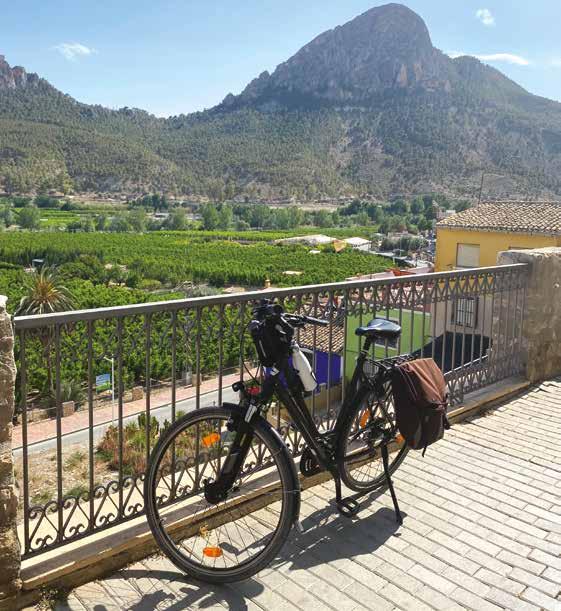
“Without a pane of glass between you and your environment, you are part of the landscape.”
Below Camargue flamingos are the largest European population of pink flamingos
Right When cycling, nothing stands between you and the places you visit

Caitlin Overend, Explore’s Marketing Manager for Canada and the US, recently went on her very first cycling trip from France to Spain. She told us all about it.
Setting off on my very first small group cycling holiday, I was nervous about keeping up, fitting in, and whether I’d chosen the right adventure – back then I didn’t know yet that sharing handlebars and hills with strangers would be an amazing experience.
There’s something magical about the rhythm of riding through a new landscape. We’d naturally fall into comfortable clusters, chatting easily during gentle stretches, then spreading out to energetic climbs at our own pace. Nobody was left behind and our Tour Leader Peter always ensured everyone felt supported and celebrated, plus there were plenty of rest stops and picturesque towns to check out on the way. One of my favourite cycling routes was in France. We were biking through the protected wetlands of the Camargue, far removed from any traffic and surrounded by nature. We saw lots of flamingos, too – it felt very magical!
The beauty of cycling holidays isn’t just the destinations; it’s the shared journey that bonds you. One of my fondest memories from the trip was at our family-owned hotel in Figueres. The on-site restaurant was absolutely incredible –hands down some of the best food of the trip. We all loved the staff so much that the entire group chose to gather there for dinner together. They arranged a large circular table so we could all chat easily, and we spent hours eating, laughing, and sharing plates of incredible seafood, meats, and pastas. Even the hotel staff joined in the fun, and for one unforgettable evening, it truly felt like we were part of the family.
Would you like to experience Caitlin’s cycling tour for yourself? She went on our Cycle Marseille to Barcelona trip explore.co.uk/CFS

The leisurely cyclist – Cycle Puglia
Discover the heel of Italy on our leisurely cycling tour through the hill towns, farmlands and coastline of sun-soaked Puglia. Along the way, sample Pugliese cuisine, tasting cheeses from a local ‘caseificio’ , produce from a family-run bakery and tipples at local vineyards. explore.co.uk/CIP
The enthusiastic discoverer – Cycle Sri Lanka
Discover the Pearl of the Indian Ocean on two wheels. Taking a circular route around the island, you’ll see ancient temples and fortresses, tea plantations and sprawling national parks. Pedal through the scenic Knuckles Range, around the ancient city of Polonnaruwa and search for leopard in Yala National Park before winding up on the white sand beaches of Koggala for a well-earned rest. explore.co.uk/CSL
The challenge seeker –Cycle Nicaragua to the Panama Canal Journey through Central America by bike, ticking off three Central American giants –Costa Rica, Nicaragua and Panama. Ride past volcanoes, through cloud forests and witness the famous Panama Canal. explore.co.uk/CNCP
Let us tell you more about what we’ve been up to in recent months.
We’ve got some cracking new trips ready to roll out, and they’re bound to be right up your street.

Discover a side of Japan that few travellers reach. Our brand-new nine-day Kyushu adventure takes you to the country’s third-largest island, where dramatic landscapes, bubbling hot springs and rich culture await. Explore the vibrant cities of Fukuoka and Nagasaki, enjoy an overnight stay in a traditional ryokan, and sample the region’s famous tonkotsu ramen. explore.co.uk/JPK
Discover the magnificent scenery and rich cultural heritage of the Val di Fassa in the Central Dolomites on this week long walking holiday. Hike beneath towering peaks, explore legendary landscapes, and unwind in a 4-star spa hotel in charming Campitello di Fassa. explore.co.uk/DWC


Discover Colombia’s captivating contrasts in absolute style during this unforgettable week-long adventure. Journey through vibrant, bustling cities, lush coffee-carpeted hillsides and stunning tropical Caribbean shores, whilst immersing yourself in the incredibly warm and welcoming spirit of Colombia’s locals. explore.co.uk/DCO
Explore is committed to protecting animals and the natural world on tours, working collaboratively with animal charities to develop comprehensive wildlife protection policies that ensure responsible travel experiences.

Explore’s Animal Protection Policy is a live and evolving framework that goes beyond static guidelines. We actively collaborate with charity partners, consultants, tour leaders, and ground agents to continuously improve animal welfare standards. This approach emphasises transparency, acknowledging both strengths and weaknesses while building mutual understanding across the industry.
Key action points:
Collaborative approach – Working with animal charities, tour leaders, and industry experts
Continuous improvement – Live policy that evolves with industry needs and best practices
Transparent communication – Open channels for customer and staff feedback on animal welfare
Comprehensive training – Online modules and specialist resources for all staff and suppliers
Violation reporting – Clear procedures for reporting and addressing animal protection concerns
Industry leadership – Building partnerships to drive positive change across responsible travel

Recipe
When travelling in Albania, one thing you will see in lots of local menus is fresh byrek, a flaky and crispy savoury pie made with filo pastry layers. It comes with a variety of delicious, sweet or savoury fillings from meat, cheese to a variety of vegetables or fruit – we decided to go with spinach for this one. Enjoy!
Ingredients:
12 sheets of filo pastry
500g spinach
A block of feta cheese
6–8 spring onions
1 bunch of dill
2–3 tbsp Greek yoghurt
2 eggs
1/2 tbsp sea salt
Salt and pepper to taste
Instructions:
1. Wash and dry the spinach. Add to a large bowl with ½ tbsp salt.
2. Finely chop the spring onions and dill. Add to the bowl with the spinach.
3. Crumble the feta cheese into the bowl.
4. Lightly whisk 2 eggs and add them to the other ingredients.
5. Add 2-3 tbsp of Greek yoghurt and mix well.
6. Take a sheet of filo pastry. Fold over a corner and add a straight line Visit our policy document to understand how we’re building back better for wildlife protection on explore.co.uk/ animalprotectionpolicy
of filling. Roll the pastry over the filling and continue rolling into a sausage shape. Twirl into a spiral shape and set aside.
7. Preheat oven to 180°C.
8. Grease the bottom and sides of a baking dish (a circular dish works well).
9. Place your filled spiral in the centre of the dish.
10. Take another sheet of filo, add filling along the long side and roll up. Add this to your baking dish, wrapping it round the edge of your spiral shape.
11. Continue with the remaining sheets of filo and filling, until you get to the edge of your dish.
12. Generously brush the top with olive oil, before putting it into the oven to bake for 50 minutes.
13. Keep an eye on the pie while it bakes, and once the top is golden brown, cover it with foil to prevent it burning.
14. Once baked, allow to rest for 15 minutes before serving.

What Astro-tourism expert Jamie Carter doesn’t know about a solar eclipse isn’t
worth knowing. And if you fancy chasing the next one, you’re in for a treat – we’re about to enter a golden era of eclipse opportunities.
Iexperienced my first total solar eclipse on 14 November 2012, an hour after sunrise from a crowded beach at Palm Cove in Queensland, Australia. It had rained all night, and the clouds blocked the sun until, with the eclipse at 99% and just minutes from totality, they parted. A resigned silence had reigned since sunrise, but now everyone on the beach was chatting. It was 6:37 a.m. In one minute, my world would change forever. The temperature, which had been rapidly rising since dawn and then stalled, now dropped sharply. I shivered under a palm tree as the light turned silvery, and everyone went quiet. Eclipse glasses were removed. As the last drop of sunlight disappeared, the beach went dark in just a few seconds. I looked up and in place of the sun was a hole in the sky. Around the moon’s black silhouette, the sun’s ghostly solar corona – an ethereal halo of wispy white tendrils – was revealed. “Oh my God!” said someone, possibly me. After the beauty came a primeval dread. The sun had gone. Do we know definitively that it will come back? If it doesn’t, it’s the end of the world. Two minutes and two seconds after it began, the first drop of sunlight re-emerged from behind the moon to form a diamond ring as fear turned to joy. A pink flash lit up the clouds on either side before the sun’s glare became too bright to look at once again. Light and heat returned. I walked the beach in utter disbelief, past people hugging each other, others excitedly chatting. Now fully understanding why people travel the world to experience totality, I had only one question left: when and where is the next one?
A total solar eclipse occurs when a new moon passes directly between Earth and the sun, perfectly aligning with the sun from the point of view of somewhere on Earth. It’s the result of a cosmic coincidence – the sun is 400 times larger than the moon, but it’s also 400 times farther away, making their apparent sizes match in our sky. During totality, the moon casts a narrow shadow – a “path of totality” – onto Earth. Only within this path (which is typically about 150 miles wide and 9,000 miles long but often occurs over oceans) can observers witness totality and gaze, with the naked eye, at the sun’s corona. The trick is to position yourself where
With growing awareness, the eclipse tourism market is experiencing a surge in popularity. Here are a few beginner tips:
Choose your eclipse
Try to plan a trip that includes much more than just the eclipse, but don’t rank eclipses on the length of totality – even a few seconds will give you the experience you’re chasing.
Book early
Hotels and tours in the path of totality fill up fast, so book years in advance if you can. Expert-led tours and cruises should maximise your chances but remember that large land-based tour groups likely won’t chase clear skies.
Scout your site
Use an augmented reality sky app like PhotoPills to ensure you have a clear view of the sun, especially if it’s low on the horizon (close to sunrise or sunset).
Check the weather
Although a cloudy eclipse means profound darkness, seeing the corona requires clear skies. Use eclipsophile.com to find the best climate, then check the weather forecasts three days in advance. Always have a Plan B – eclipse chasing is cloud dodging.
Pack smart
Bring eclipse glasses (for the partial phases), a hat, sunscreen and binoculars with a solar filter. Don’t waste time photographing your first eclipse –you’ll regret it.

Below
the sky is likely to be clear at that time of year and be relatively close to the centreline of the path, where totality lasts for the longest time – typically a few minutes. For many, those minutes are life-changing, so where you go is always a big decision.
To outsiders, eclipse chasing may seem obsessive. But for those who have stood in the shadow of the moon, the appeal is obvious. I’ve travelled to nine since 2012, witnessing everything from flocks of birds going crazy to groups of eclipse chasers in floods of tears. For some, it’s the sheer beauty. Others think of loved ones, now departed, wishing they were still here to share the moment.
“To outsiders, eclipse chasing may seem obsessive. But for those who have stood in the shadow of the moon, the appeal is obvious.”
A total solar eclipse isn’t just a turn-up, see-it-andleave-again affair. It’s a chance not only to discover new places but to see them at their luckiest. Totality visits the same location once every 366 years, on average, so for local communities, it’s a massive occasion.
Unless, of course, you travel. Eclipse chasing is currently a booming industry, thanks in part to the 2024 eclipse, which was witnessed by an estimated 50 million people in Mexico, the U.S., and Canada. Many of them want to experience another.
Part of the appeal is the journey: total solar eclipses occur somewhere on Earth roughly every 18 months, but rarely in the same place twice. Chasing them means planning travel to remote deserts, icy fjords, ancient ruins, and windswept beaches. For many, the eclipse becomes the nucleus of an unforgettable adventure. Get yourself a list of when and where the next total solar eclipses are, and
The next few years are a golden era for eclipse tourism, with some glorious travel opportunities:
12 August 2026
A dramatic twilight eclipse in Greenland, Iceland and Spain, with the sun low in the sky. Inland Spain offers the best odds for clear skies, but Iceland gets the longest totality (2 minutes 13 seconds).
2 August 2027
The longest totality of the century (6 minutes 22 seconds) from Luxor, Egypt, will draw eclipse chasers, but the path also visits southern Spain, Morocco, Algeria, Tunisia, Libya, Saudi Arabia, Yemen and Somalia.
22 July 2028
Sydney Harbour will experience totality for almost four minutes, though it tops five minutes over probably cloudless Outback Australia, north of Broome and Alice Springs. In New Zealand’s South Island the eclipse will occur close to sunset.
25 November 2030
A sub-two-minute totality just after sunrise from Namibia, Botswana and South Africa, with totality close to sunset in South Australia, New South Wales and Queensland. Safari and stargazing opportunities abound.
Interested in going on an eclipse trip? Check out our tours here explore.co.uk/eclipse-trips


you can book time off work well ahead of time (until the year 3000, in fact!). You’ll be in good company; eclipse chasers are the best-travelled people you’ll ever meet.
The next total solar eclipse will see a path of totality move from the Arctic to eastern Greenland, western Iceland and northern Spain – three stunning regions popular with tourists, regardless of the eclipse. It’s Iceland’s first totality since 1954 and mainland Spain’s first since 1905. “What makes the 2026 eclipse even more special is that it’s the first of two consecutive total solar eclipses visible from parts of Spain, with the next one happening just a year later in 2027,” says Dan Zafra, a photographer who’s hoping to experience his first totality in his home country. “After that, we won’t see another total solar eclipse over Spain until 2061, so these two eclipses present a unique window of opportunity.” In Spain, the eclipse will occur shortly before sunset – a dramatic experience, but one that requires very careful planning to ensure clear sightlines. Iceland’s capital, Reykjavik, is in the path, as is Greenland’s Scoresby Sound, the latter destination for dozens of expedition cruise ships packed with eclipse chasers after an Arctic eclipse.
The allure of a total solar eclipse lies in its singularity. It’s not a sunset, a meteor shower or a firework display. It’s a dramatic transformation of the sky as the sun is revealed to be what we know it really is – a white (not yellow) star floating in a black sky. “You, the moon and the sun in perfect alignment is something worth experiencing at least once in your life,” says Dr. Rick Fienberg, a science educator who’s witnessed dozens of total solar eclipses. “No matter how much I hype totality to first timers, they always tell me afterward that it was even better than I led them to believe.”

Jamie Carter is an awardwinning journalist, eclipsechaser, astro-tourism expert, tour leader, and editor of WhenIsTheNextEclipse.com.
The natural world is full of wonder, whether it’s a once-in-a-blue-moon eclipse or a bioluminescent spectacle. We’ve chosen five of the most incredible sightings – here’s where and when to go.
The Northern Lights
ICELAND, NORWAY, OR FINLAND
A swirl of ethereal green and purple light across a star-dusted sky – the aurora borealis is one of the world’s most magical sights. Best seen between September and March, head to the Arctic Circle for your best chance of witnessing the dance of solar particles colliding with the Earth’s atmosphere.
The Great Wildebeest Migration
KENYA AND TANZANIA
This is nature at its most dramatic: over two million wildebeest, zebra and gazelle thundering across the Serengeti and Masai Mara in a year-round, circular journey of survival. Between July and October is peak time for river crossings – a heartpounding spectacle of animals facing crocodilefilled waters and predators on the prowl.
Cherry Blossom Season
JAPAN AND SOUTH KOREA
Each spring, delicate clouds of pink and white Sakura blossom transform the landscapes of Japan and South Korea into dreamlike scenes. From Kyoto’s temples to Seoul’s palace parks, the fleeting beauty of these blooms (typically March–April) is celebrated with flower festivals, picnics under the petals, and a deep sense of appreciation for the moment.
The Salmon Run
BRITISH COLUMBIA, CANADA
Every autumn, millions of salmon swim upstream to their birthplace in a defiant final act of life. The sight of rivers teeming with determined fish is spectacular in itself – but it’s also a prime time to spot black bears, bald eagles and even wolves that gather for the feast. Head to the rivers of Vancouver Island or the Fraser River between September and November
The Glowworm Caves
WAITOMO, NEW ZEALAND
Step into a subterranean wonderland illuminated by thousands of tiny glowworms that sparkle like stars in the darkness. The Waitomo Caves offer an otherworldly experience as you drift silently on a boat beneath ceilings twinkling with bioluminescent light. This magical spectacle is year-round, making it a must-see natural marvel in New Zealand.
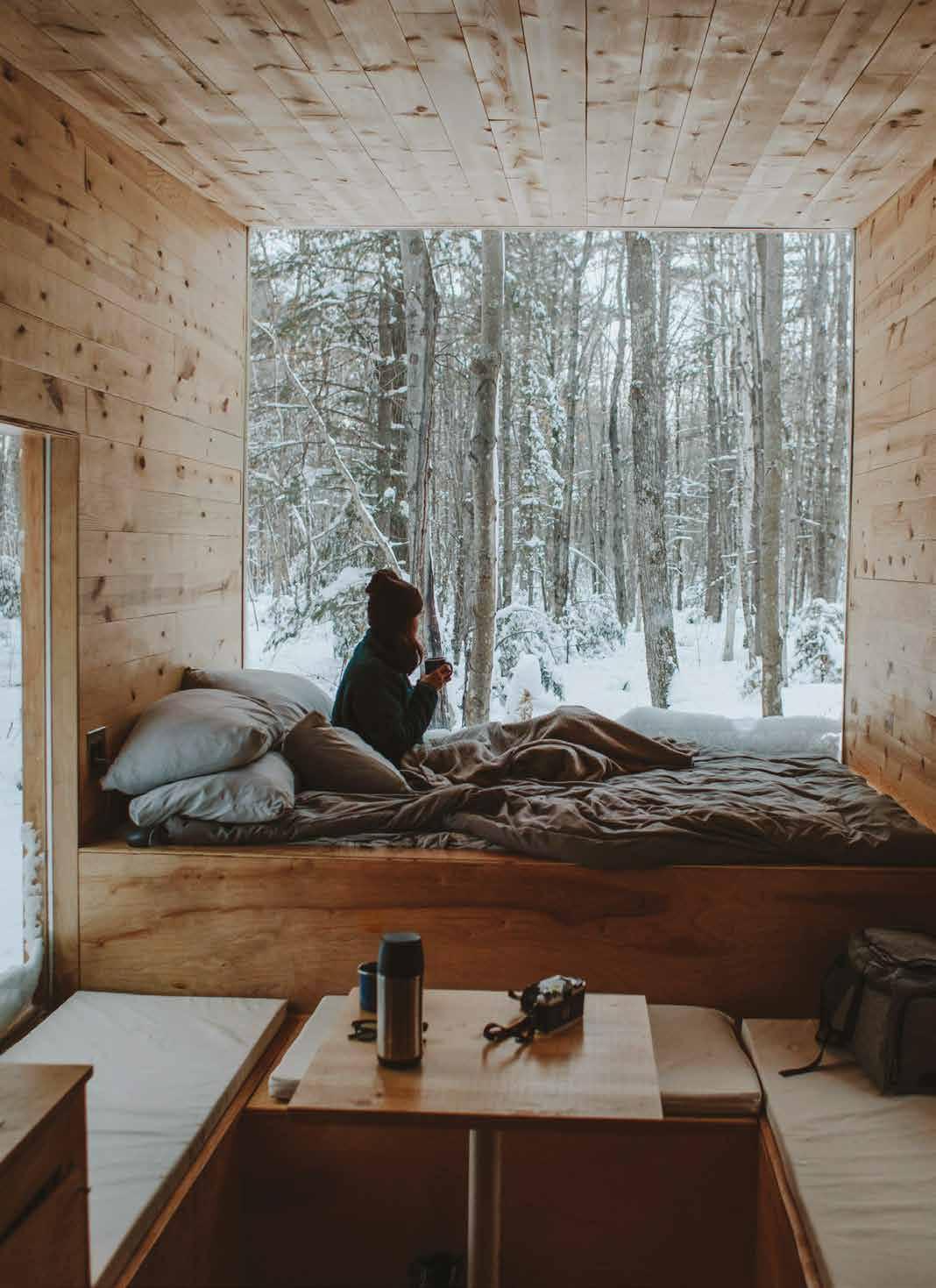
From remote cabins in Oregon to camping in Mongolia, unplugged travel has never been more in demand. But could you cope with a week without Wi-Fi? Amanda Statham investigates.
The need for total disconnect from our increasingly digital lives has never been greater. In a world where doom scrolling, checking emails and clicking on Facebook alerts day and night is the new norm, we’re overloaded, overstimulated and desperate for a break from it all.
Which is why digital detox holidays are so much in demand. As the lines between work and home become increasingly blurred, the need for separation is stronger than ever and the inevitable backlash has begun –we’re craving places without TVs, phone signal or Wi-Fi.
According to a recent 2025 Hilton Trends report, 27% of adults say they intend to reduce social media during their holidays, but many want to go further and ensure they not only reduce it but ditch it altogether, at least for a week or two.
To those from a generation who remember what life was like before the Internet, a digital detox might not sound like a big deal, but for anyone who has grown up with a screen the thought of being completely cut off can be unnerving –being connected feels more necessity than need.
Yet the advantages to switching off are proven to be so great, from better sleep to lower blood pressure and reduced anxiety, it’s vital that holidays allow us time to truly disconnect. The solution is to stay somewhere where the decision is made for you, a place where there’s no option but to switch off and combat the burnout that comes from the daily digital grind.
Resorts such as Kamalaya in Thailand, for example, have introduced a digital detox break, where you surrender your smartphone and there’s no Wi-Fi, TV or technological devices – it’s just you and your natural surroundings.
Very The White Lotus 3. Meanwhile Hyde Bodrum resort in Turkey has introduced ‘Disconnect Dinners’ at its restaurant overlooking the ocean, where your phone is handed in on arrival, meaning you’re forced to watch the sunset rather than your screen.

Yoga teacher Hannah Campbell, who co-runs digital-free Benourished retreats in the UK and abroad, says guests tend to arrive with some resistance and anxiety about being away from devices. To ease the process she helps them set boundaries ahead of the retreat, such as creating an ‘out of office’ for emails, and letting loved ones know the venue’s phone number incase of emergencies. The result? “By day two the disconnection from tech allows for a deeper connection, sense of freedom and headspace.”
Technoference (the way in which technology disrupts our human interactions) is particularly relevant to families, with many parents becoming increasingly exasperated at trying to interact with a screen-addicted teen.
Gen Z and Gen Alpha are the first generations to have come of age fully online and excessive screen time is a big problem. According to digital wellbeing site It’s Time To Log Off, UK children spend at least six-and-a-half-hours a day on screens, meaning they are literally scrolling their lives away. Little wonder so many parents want to use precious
family holiday time to disconnect from devices and reconnect with each other.
TV director Simon Hynd and his wife Michelle took their two teens Ellen, 14, and Dylan, 16, to stay in an off-grid cabin in Portland, Oregon and say they all reaped the benefits.
“I loved it,” says Michelle, “as screens are a constant source of tension and arguments in our family – me wanting the kids off and engaging in the real world, but the kids disappearing down endless online rabbit holes”. She says the reaction from the kids to no Wi-Fi is always the same: like they’ve had a limb removed and will never, ever recover.
“However once they adjusted we had a great time. We played card games and charades, went for walks and prepared and ate delicious food. I’d love it if there were more places without Wi-Fi as it enables you to switch off properly and connect with one another.”
Disconnecting from technology often means connecting more with the present moment. People who embrace the opportunity to unplug frequently report having more meaningful conversations and travel experiences




Above
Looking
for
a green place to disconnect? The wide planes of Mongolia could be what you’re after
Above right
Did you know that water environments have restorative psychological effects – the sounds alone can reduce stress hormones and promote relaxation
With so much of the world now online, it’s harder than ever to fully escape the World Wide Web (I’ve received messages about non-uniform days from the school mum’s WhatsApp group while in the Okavango Delta in Botswana). Thankfully some travel experiences do still exist where it’s possible to fully unplug, at least for part of the trip.
For example during a 15-day Mongolia Explorer getaway there’s no choice but to abandon your devices as you’ll be staying in an authentic off-grid Mongolian Ger camp while discovering the Gobi Desert and sacred Orkohn Valley. The main restaurant tent might have enough electricity to charge your camera battery, but that’s about it.
“I’d love it if there were more places without Wi-Fi as it enables you to switch off properly and connect with one another.”
Sailing down the Brazilian Amazon on a boat without Wi-Fi means you’re forced to immerse yourself in the rich ecosystem surrounding you rather than commenting about it on social media.
The Maldives archipelago might be remote, but most of the five-star resorts have faster Wi-Fi than home. Not so on an eight-day Maldives Dhoni Cruise, where you’re able to disconnect and spend your time on board diving, exploring uninhabited islands and sleeping on deck beneath the stars rather than scrolling.
Nothing focuses the mind like a long walk, take it to the next level with a Kilimanjaro Trek where there’ll be no Wi-Fi and virtually no phone signal, meaning all you have to concentrate on is reaching the summit (the highest point in Africa). Or how about trekking the Inca Trail in Peru? Nine days WiFi-free and virtually no phone signal, allowing you to fully absorb the beauty of the Andes Mountains and magnificent Machu Picchu.
With more than half of teenagers in the UK admitting they feel addicted to social media, according to data from the Millennium Cohort Study, it’s no wonder parents are looking for digital detox holidays for teens. Here’s how to make it as pain-free as possible.
Be the change
Model the behaviour you want to see. If you can’t put your own phone or laptop down, how can you expect your teen too? Commit to a screen-free holiday, and stick to it.
The old switcheroo
Make sure there are plenty of replacement activities. Smartphone use and social media is addictive and when they can’t access them they’re going to experience withdrawal symptoms, so it’s good to plan an itinerary with plenty of distractions, from hikes to white water rafting.
Out of sight out of mind
Keep screens out of sight. Put phones (yours included) in a bag at the start of the holiday and keep them there for the duration.
Old-school camera
Invest in a digital camera. They’ll want to use their phone to take pictures, but encourage them to take snaps on a camera instead and reduce temptation.
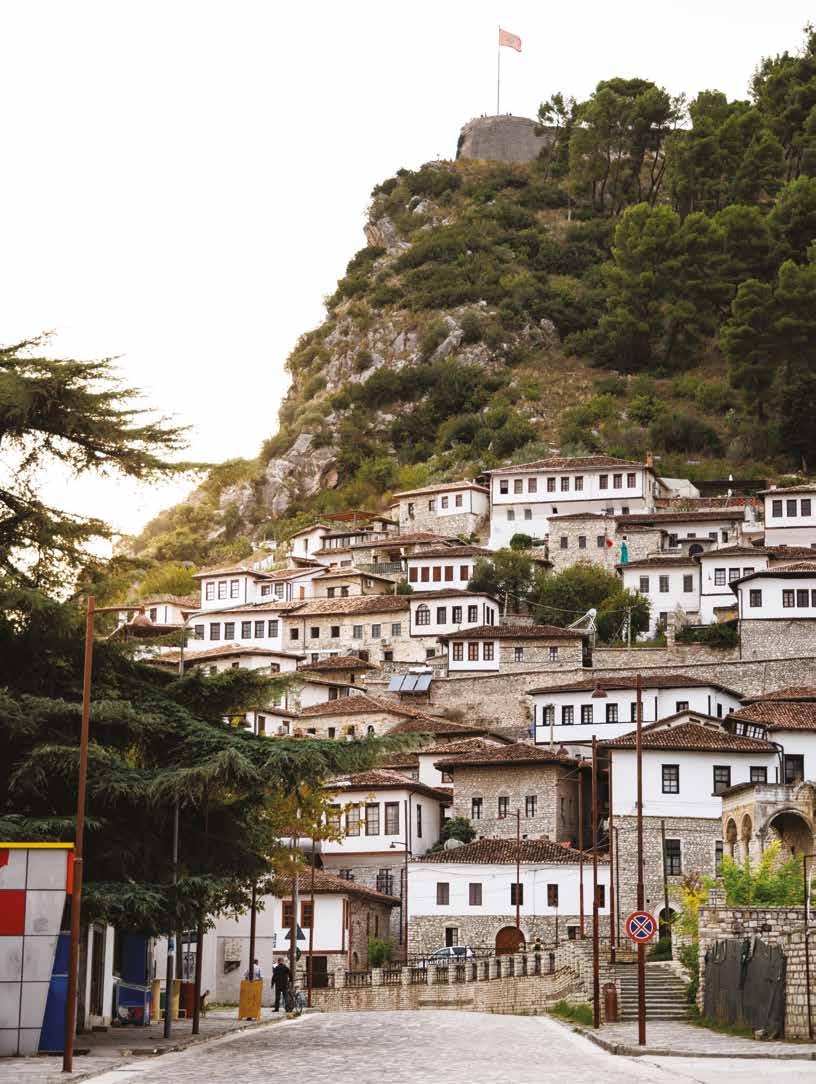

Albania is one of Europe’s best-kept secrets – it’s wild, welcoming, and full of surprises. From rugged mountain passes to sunsoaked beaches, and ancient ruins to Cold War bunkers, it’s a country built for curious travellers. Compact yet diverse, it rewards those willing to go off the beaten path and explore deeply.
Albania, a small Balkan nation on Europe’s southeastern coast, is tucked between Montenegro, Kosovo, North Macedonia, and Greece. Though similar in size to Belgium, it offers an impressive diversity of landscapes and a rich cultural heritage.
Framed by both the Adriatic and Ionian seas, and with nearly 70% of its terrain covered in mountains, Albania’s geography is as dramatic as it is beautiful. These natural features have shaped the country’s identity over thousands of years, forming barriers that helped preserve unique regional cultures while also drawing the attention of empires eager to claim its strategic vantage points.
Albania’s story begins with the ancient Illyrians, tribes who inhabited the region more than 2,000 years ago. The Romans later conquered these lands, followed by the Byzantine Empire, but it was the Ottoman occupation, from the 15th to early 20th Century, that left the most lasting cultural imprint on modern Albania.
In the 15th Century, national hero Gjergj Kastrioti, known as Skanderbeg, emerged as a legendary leader who united Albanian princes against Ottoman rule and prevented the empire from extending further into the European continent. His red flag bearing the double-headed eagle became a powerful symbol of resistance and is now Albania’s national emblem, earning the country its nickname, “Land of Eagles.”
After World War II, Enver Hoxha’s communist regime isolated Albania for nearly five decades. In a climate of deep paranoia, the government constructed over 700,000 concrete bunkers across the landscape in preparation for an invasion that never materialised. The country became a hermit state where Albanians were forbidden to leave, and foreigners were rarely permitted entry. Those few visitors who did gain permission faced strict controls – they were required to have approved haircuts, wear government-sanctioned clothing, and were constantly monitored. The Sigurimi, Albania’s secret police, maintained surveillance over thousands of citizens, with many dissidents disappearing or facing imprisonment.
Since the fall of communism in 1991, Albania has undergone a remarkable transformation. The effects of 50 years of isolation were profound, with the country having missed out on entire cultural movements like rock music, fashion trends, and technological advances. But in the decades since, Albania has not only absorbed these changes, but it has also caught up quickly, emerging as a dynamic, forward-looking society that blends tradition with modernity.
Albania’s cultural identity reflects its unique position at the crossroads of civilisations. The country is remarkably diverse religiously, with Muslims, Orthodox Christians, and Catholics coexisting peacefully, a testament to Albanians’ traditional tolerance and the saying “the religion of Albanians is Albanianism.”


“The country is remarkably diverse religiously, with Muslims, Orthodox Christians, and Catholics coexisting peacefully, a testament to Albanians’ traditional tolerance and the saying “the religion of Albanians is ‘Albanianism’.”
This spirit of tolerance is written into the very landscape through Albania’s architecture. Ottoman-era mosques with elegant minarets stand alongside Byzantine churches and Venetian towers, telling the nation’s story through stone and mortar. The UNESCO World Heritage Sites of Gjirokastër and Berat showcase perfectly preserved Ottoman towns with their distinctive white stone houses cascading down hillsides.
Beyond religious harmony, Albanians have fiercely guarded their most precious cultural treasure: their language. Throughout centuries of foreign rule, there’s been immense pride in preserving Albanian as one of Europe’s oldest languages with its own unique branch on the Indo-European tree – a living symbol of unbroken identity.
This cultural resilience extends to Albania’s legendary hospitality, known as besa. This ancient code of honour encompasses trust, loyalty, and the sacred duty to protect guests. Visitors often find themselves overwhelmed by locals’ genuine warmth and generosity.
Tirana, Albania’s vibrant capital, bursts with colour and character. The city’s rainbowpainted buildings and range of hyper modern
Bunker makeovers: Albania’s Cold War-era bunkers – once symbols of isolation – have been transformed into cafés, hotels, and art spaces.
A global population: The Albanian diaspora is vast – more Albanians are believed to live abroad than in the country itself.
Scarecrows for protection: Dordolec (stuffed dolls or toys) are hung outside homes to ward off the evil eye and bring good luck.
Cars: During socialist rule, the only thing Albanians were allowed to own was a bicycle. After the fall, people wanted to own the ‘best car in the world’, which in the 1990s was the Mercedes.
To this day, you will see a wide range of (sometimes extravagant) Mercedes models on the roads.
Botanical riches: Albania hosts over 3,200 plant species – 30% of Europe’s total – with 15 national parks showcasing its biodiversity.
Ancient waters: Albania is home to Europe’s oldest lake, Ohrid.
skyscrapers, reflect the optimism and creativity of a country redefining itself. Alongside its visual transformation, Tirana has embraced a rich café culture that’s at the heart of daily life.
Cafés double as informal gathering places where friends and families discuss politics, football, and everyday life. This sense of community continues into the evening, where the xhiro (stroll) tradition sees entire families walking through town centres where they reconnect with each other and social ties are reinforced.
“Albanian cuisine reflects the country’s position between Mediterranean and Balkan traditions.”
Family lies at the core of Albanian culture. Showing genuine interest in someone’s relatives is seen as a sign of respect and friendship. Extended families often live together, or at least close by, reflecting a deep-rooted sense of loyalty and unity.
Albanian cuisine reflects the country’s position between Mediterranean and Balkan traditions, creating a unique culinary identity that’s both familiar and surprising.
Traditional cooking emphasises fresh, local ingredients prepared simply to let natural flavours shine. The traditional cuisine is heavily meat or fish focussed but it is relatively easy to find vegetarian options like Fërgesë or Byrek
Here are some essential Albanian dishes worth discovering:
Tavë kosi: The national dish features tender lamb baked with rice in a creamy yoghurt sauce, creating comfort food that’s both rich and refreshing.
Byrek: These flaky pastries come filled with cheese, spinach, meat, or pumpkin. Street vendors serve them hot throughout the day, making them perfect for quick meals (see recipe on page 23).
Qofte: Albanian meatballs are typically grilled and served with fresh bread, tomatoes, and onions. Each region has its own variation and fiercely defends its recipe.
Fërgesë: A hearty dish combining peppers, tomatoes, cottage cheese, and sometimes meat, cooked in a traditional clay pot for maximum flavour.
Baklava: Albania’s version of this sweet pastry features local honey and nuts, often served during celebrations and special occasions.
Kabuni: A traditional dessert made from fried rice, mutton broth, raisins, and a spice mix of sugar, cinnamon, and ground cloves.
Raki: Albania’s national spirit deserves a special mention. This potent brandy, often homemade, accompanies nearly every social gathering and can be had before, during and after the meal. Boza, a traditional fermented drink, offers a non-alcoholic alternative and has a unique sweet-tart flavour.
Watch:
Film: Sophia (2022) by Eduart Grishaj – a love story about war, memory and forgiveness (that nicely showcases Albanian hospitality and some humorous contradictions of the country).
Documentary: The Secret History of Albania – explores the country’s isolated communist period.
Read:
Broken April by Ismail Kadare –Albania’s Nobel Prize-nominated author.










“I can confirm we heard lots of screams, though most likely attributable to local kids messing about.”






This Halloween, skip the party crowds and hopped-up trick-ortreaters by heading into the quiet of the woods for an eerie evening. Bring your flashlights, and maybe some blessed salt too, and join our Amy Fiske as she creeps through our top haunted hikes around the world.
First on this list is also first on my travel wish list for spooky destinations; Romania is a treasure trove for the macabre tourist. Being ‘geographically cursed’ Romania has seen its share of horrors. As well as home to Count Dracula and Vlad the Impaler, Romania is home to witches of all varieties – in fact, the government introduced a spell tax because witches’ selling readings, hexes and heals became big business. Romania is also home to the Hoia Baciu Forest. For hundreds of years people have been going missing in this forest, some returning years later, unaged and with no memory of what’s happened. With both ghosts and UFO sightings having been reported in the area, could aliens or the supernatural be responsible for these abductions? Would you dare to set foot in what is known as the world’s most haunted forest?
Whilst a fantastic heading for this listicle, Dead Woman’s Pass on the Inca Trail isn’t named after any tragedy that might cause a haunting. It’s named after the mountain’s shape, which resembles a woman lying down. Whilst hiking the Inca Trail, be mindful of Incan apparitions thought to protect this spiritual landmark. Reported encounters include a feeling of being strangled in the night while camping here. Is this true or just a weird side effect of altitude sickness? This famous trail leads to world wonder Machu Picchu. As tourists curse the fog that ruins their photos, locals listen for whispers of lost souls.
3
The Appalachian Trail runs over 2,000 miles through 14 US states and passes through many old remote towns, including several abandoned villages, as well as – you guessed it – Native American land. The Appalachian trail and surrounding mountains are attached to a wealth of not only ghost stories but monsters too. With the strong community swapping stories along the route, no wonder campfire stories are living experiences. My favourite tale is that of the residual haunting of a hiker who is thought to have died lost on the trail. People don’t even realise he’s a ghost until he disappears into thin air, which makes you wonder… How often do we walk past a ghost without even realising?
4 5
Aokigahara, meaning ‘Sea of Trees’, is a beautiful and dense forest with a lava-formed floor that makes going off trail risky. In ancient Japan, the sick and elderly were once left here to die, giving rise to tales of lingering spirits known as yurei. Unlike the mischievous yokai spirits, yurei are said to scream through the forest at night and seek vengeance. Now widely known as the ‘Suicide Forest’, Aokigahara has gained a tragic reputation. While several social and pop cultural factors contribute to this, some believe the yurei manipulate people to their fate. If you do plan to hike here, be sure to stay on the trails and, as in western culture too, carry salt to ward off negative spirits.
This charming, picturesque town in southeast England received a Guinness World Record for Most Haunted Village in Britain, with up to 14 spirits thought to reside here. Not only is the town haunted but the local woods, Derring Woods, is nicknamed the Screaming Woods (having spent the night nearby I can confirm we heard lots of screams, though most likely attributable to local kids messing about). I did a self-guided ghost walk here which featured a ghost story at every stop, including the story of a drowned traveller woman, who may have spoken to us through dowsing rods that evening, and – my favourite – a scandalous love triangle that ended in poisoning. After your ghost walk, make sure you finish at the, also haunted, Black Horse pub to help raise some more spirits.
The joy of a great book is that it can transport you –whether that’s into a different place, another era, or just a fresh perspective. Here we round up four of our favourite recommendations from the Four Corners Book Club, shared by you – our travellers!

PERFECT FOR… SPRING
The One-Hundred-Year-Old Man
Who Climbed Out the Window and Disappeared, Jonas Jonasson
Spring is a season of new beginnings, and this novel shows it’s never too late to start.
“While travelling in Sweden you may come across some unusual people, Sweden is full of them! Enhance your visit by reading the story of Allan Karlsson, the 100-year-old adventurer before you go, and you’ll surely enjoy your visit even more! Of course, Allan is fictional, and so are his adventures, nevertheless, the indomitable spirit of the Swedish race will be less of a mystery to you.”
Recommended by Veronica

PERFECT FOR… SUMMER
Driving over lemons, Chris Stewart
Nothing conjures hazy summer days like this memoir, set in the Alpujarras in Spain.
“The memoir is all about embracing a radically different way of life and finding it totally suffused with joy. Set in a tiny, isolated valley in the mountains, the book paints the most vivid picture of the landscape. You feel like you’ve walked through the olive groves, the rushing rivers and the jagged mountains.”
Recommended by Natasha
*P.S. Did you know? Explore UK staff have their own monthly book club – inspired by your very own recommendations! So, keep ‘em coming!


PERFECT FOR… AUTUMN*
*Explore Staff Bookclub Pick!*
The Mercies, Kiran Millwood Hargraves
It’s spooky season, and this gripping tale about witchcraft and isolation on a remote Norwegian island will have you spellbound. “This is such a haunting book. Set in Norway in the early 17th century, all the island’s (fisher) men are wiped out by a huge storm, leaving the women to find their own way to survive and thrive. Until men are sent from Scotland to root out witchcraft.”
Recommended by Laura
Read more spooky tale inspiration on page 36.

PERFECT FOR… WINTER
Murder on the Orient Express, Agatha Christie
Snowed-in suspicions and an edge of your seat reveal put this iconic whodunnit top of our TBR. All aboard for a murder mystery set during the golden age of train travel from the inimitable Agatha Christie. On a technical level alone, this is an astounding read. But it’s also funny, snarky, and deliciously intriguing. Christie’s description of Poirot bundled up in multiple coats as nothing but “a pink-tipped nose and an upturned moustache” is particularly charming; you can just feel the bitter winter cold encircling the passengers, the snow drift cutting them off and heightening the isolation and tension.”
Recommended by Sarah
Are you looking for some more reading inspiration or have a recommendation of your own? Check out the Four Corners Book Club. Now also with non-fiction suggestions! explore.co.uk/bookclub

Belize is a gem that will take you from spectacular to unbelievable with its mix of exotic wildlife, lush forests, white-sand beaches, and ancient sites. Visit and dive into some of Central America’s best snorkelling spots, explore the Crooked Tree Wildlife Reserve for local wildlife, and discover the ancient Maya temples at Xunantunich and Lamanai.
Check out our discovery and family tours in Belize now.

Find out more


